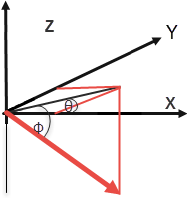Generalised Derivative
Use the Grid and Image > Filters > Generalised Derivative menu option (geogxnet.dll(Geosoft.GX.GridUtils.GeneralisedDerivative;Run)*) to calculate the curvature of the potential field response of a grid.
The option is also available with the 2D Filtering extension under the 2D Filtering menu.
Generalised Derivative dialog options
|
|
Select the name of the input grid to filter. Script Parameter: GENERALISED_DERIVATIVE.INPUT |
|
|
Specify the name of the output grid. Script Parameter: GENERALISED_DERIVATIVE.OUTPUT |
|
|
Specify the horizontal azimuth angle (θ) relative to East, in the counter clockwise direction. Script Parameter: GENERALISED_DERIVATIVE.AZIMUTH |
|
|
Specify the vertical dip angle (φ) along the normal to the positive Azimuth direction. When looking towards the positive direction, the dip angle is specified on your right hand side, from the horizontal. Script Parameter: GENERALISED_DERIVATIVE.DIP |
|
|
Select the derivative method as FFT or Convolution (CONV) for generating the vertical derivative of the input grid. Default is FFT. Script Parameter: GENERALISED_DERIVATIVE.METHOD |
|
Retain derivative grids |
Select to retain the derivative grids. The Generalised Derivative process creates the X,Y,Z derivatives as a by-product of this process. Saving these grids will speed up the progress next time you run the generalised derivative using the same input grid. If this check box is selected, the intermediate derivative grids ( _dx.grd, _dy.grd and dz_grd) will not be deleted on exit. Script Parameter: GENERALISED_DERIVATIVE.RETAIN [Checked:1 | unchecked:0] |
Application Notes
 ) indicates a required parameter.
) indicates a required parameter.
The curvature of the potential field response is a useful attribute that can be used to enhance the signal and bring out the small detail obscured by large amplitude anomalies. Specifically, the ratio of the total horizontal derivative over the analytic signal emphasizes the potential field in a specific desired direction. The generalised derivative operator (GDO) has the form:
Where:
φ is the inclination
θ is the declination of the direction to emphasize
If φ =0, the GDO reduces to the horizontal component of the field and has its maximum direction sensitivity along θ.
If φ =90, the GDO reduces to the Z component of the field and like the analytic signal has no directional bias.
The GDO uses the vertical derivative of the field and allows the derivative of the field in any direction in the 3D space with any desired degree of directional sensitivity. The sun shading filter responds to the edges of a magnetic source, while the GDO responds either to the edges or to the whole source or anywhere in between, depending on the value of φ.
*The GX.NET tools are embedded in the geogxnet.dll file located in the \Geosoft\Desktop Applications\bin folder. To run this GX interactively (outside the menu), first navigate to the bin directory and provide the GX.NET tool in the specified format. See the Run GX topic for more guidance.
Reference
- [1] G. R. J. Cooper and D .R. Cowan, "A generalized derivative operator for potential field data", Geophysical Prospecting, vol. 59 (2011), pp. 188–194.
Got a question? Visit the Seequent forums or Seequent support
Copyright (c) 2025 Bentley Systems, Incorporated. All rights reserved.
Privacy | Terms of Use

 Input grid
Input grid
